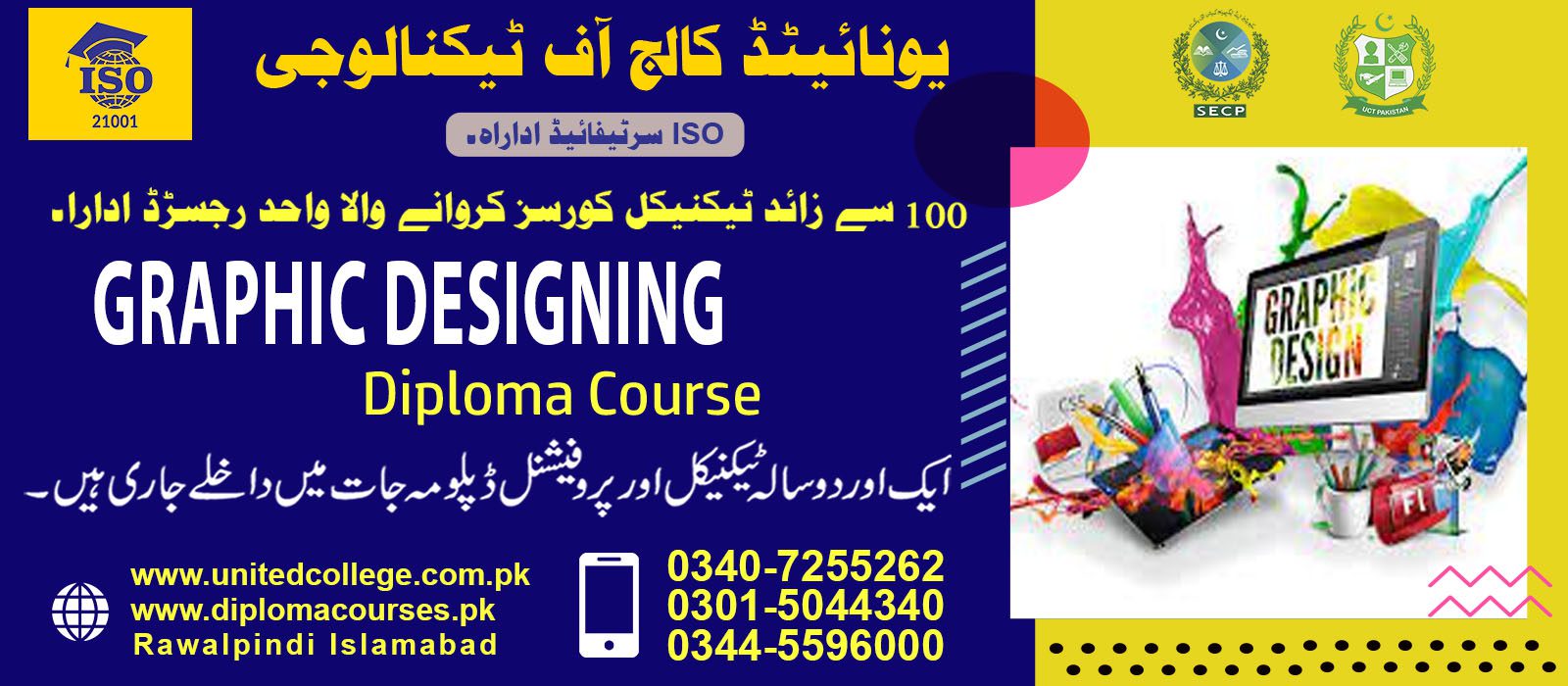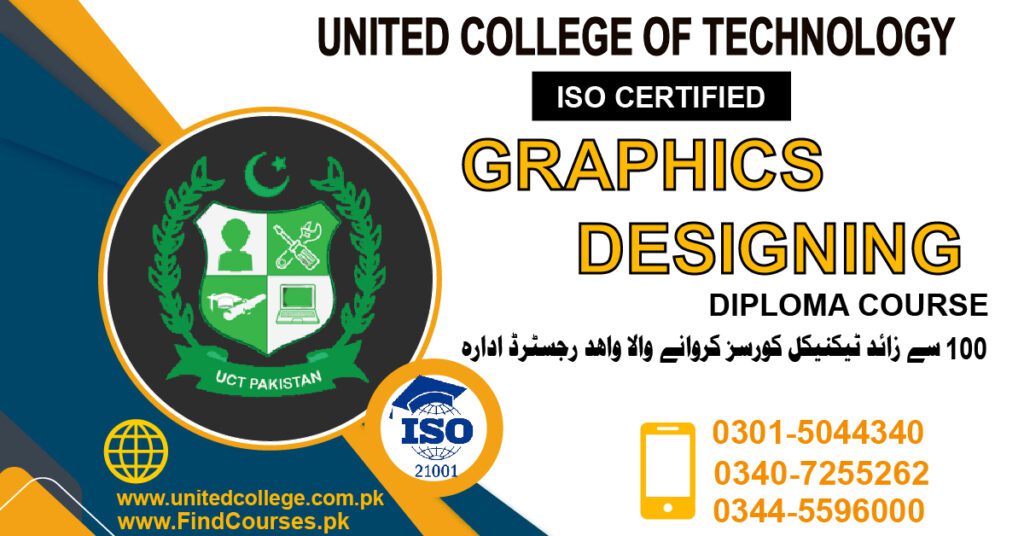GRAPHIC DESIGNING COURSE IN RAWALPINDI ISLAMABAD PAKISTAN

Graphic Designing Course in Rawalpindi Islamabad Pakistan 0344-5596000
Introduction:
Graphic Designing is the art and practice of creating visual content using various elements such as typography, images, colors, and layout. It involves combining creativity and technical skills to communicate ideas, convey messages, and solve visual problems through visual representations. Graphic designers use various tools and software to create designs for both print and digital media.
Graphic Designing encompasses a wide range of design disciplines, including:
- Branding and Identity Design:
-
- Creating visual identities for businesses and organizations
- Designing logos, brand guidelines, and marketing collateral
- Print Design:
-
- Designing layouts for magazines, newspapers, brochures, and posters
- Packaging design, including labels, boxes, and product packaging
- Advertising and Marketing Design:
-
- Designing advertisements for print and digital platforms
- Creating promotional materials such as banners, flyers, and billboards
- Web and Digital Design:
-
- Designing user interfaces (UI) and user experience (UX) for websites and mobile apps
- Creating digital graphics for social media, banners, and online advertising
- Typography and Layout Design:
-
- Choosing and arranging fonts to create visually appealing and readable text
- Creating layouts for publications, websites, and other media
- Illustration and Icon Design:
-
- Creating original illustrations and icons for various purposes
- Designing custom graphics and icons for branding and user interfaces
- Motion Graphics and Animation:
-
- Creating animated graphics for videos, presentations, and websites
- Designing visual effects and motion graphics for multimedia projects
- Environmental and Exhibition Design:
-
- Designing signage, wayfinding systems, and environmental graphics
- Creating exhibition displays and booth designs for events and trade shows
- Visual Communication and Infographics:
-
- Presenting complex information and data visually through infographics
- Designing charts, diagrams, and visualizations for reports and presentations
Graphic designers work in various industries, including advertising, marketing, publishing, digital media, and design agencies. They collaborate with clients, marketing teams, and other stakeholders to understand their needs and develop visually appealing and effective design solutions.
To create designs, graphic designers use a range of software tools, such as Adobe Photoshop, Illustrator, InDesign, Sketch, and Figma, along with traditional art techniques and principles of design. They must have a good eye for aesthetics, a strong understanding of composition and color theory, and the ability to effectively communicate through visuals.
Overall, graphic design plays a vital role in creating visual experiences and communication across various mediums, helping to enhance branding, engage audiences, and convey messages effectively.
Graphic Designing Course Outline:
- Introduction to Graphic Design:
-
- Overview of graphic design principles, practices, and industry trends
- Understanding the role of a graphic designer
- Exploring different types of graphic design disciplines
- Design Theory and Principles:
-
- Understanding design elements and principles (e.g., color, typography, composition)
- Applying visual hierarchy and balance in design
- Gestalt principles and their application in graphic design
- Using contrast, repetition, alignment, and proximity effectively
- Typography:
-
- Introduction to typography and its role in graphic design
- Choosing appropriate fonts and typefaces for different design purposes
- Kerning, tracking, and leading for effective text layout
- Creating hierarchy and readability through typographic techniques
- Color Theory and Application:
-
- Understanding color psychology and its impact on design
- Color schemes, harmonies, and combinations
- Using color effectively for branding and visual communication
- Color management for print and digital media
- Layout and Composition:
-
- Grid systems and their role in layout design
- Designing effective and balanced compositions
- Working with white space and negative space
- Designing for different print and digital formats
- Adobe Creative Suite:
-
- Introduction to industry-standard graphic design software (e.g., Adobe Photoshop, Illustrator, InDesign)
- Navigating the software interfaces and understanding essential tools and features
- Creating and manipulating graphics, illustrations, and layouts using software
- Image Editing and Manipulation:
-
- Basic and advanced image editing techniques
- Adjusting colors, retouching images, and enhancing photographs
- Working with layers, masks, and blending modes
- Vector Graphics and Illustration:
-
- Introduction to vector graphics and their advantages
- Creating and editing vector illustrations and logos
- Using shape tools, pen tool, and other vector-based techniques
- Print Design:
-
- Designing layouts for print materials such as brochures, posters, and business cards
- Understanding print specifications and preparing files for print production
- Typography and color considerations for print design
- Digital Design:
-
- Designing graphics and layouts for digital platforms
- Designing banners, social media graphics, and web advertisements
- Creating UI/UX elements and prototypes for websites and mobile apps
- Branding and Identity Design:
-
- Understanding the branding process and creating visual brand identities
- Designing logos, brand guidelines, and marketing collateral
- Maintaining consistency across different brand touchpoints
- Portfolio Development:
-
- Showcasing and presenting design work effectively
- Creating a professional design portfolio
- Self-promotion and marketing as a graphic designer
Course Fee: 25000
Daily Class: 2 Hours
Course Duration: Two Months
Morning / Evening
Call For Registration: 0344-5596000 / 0333-9014677 / 0340-7255262















































































